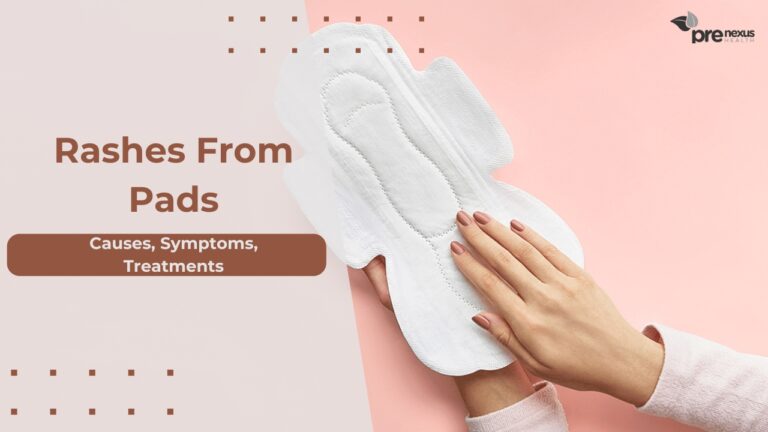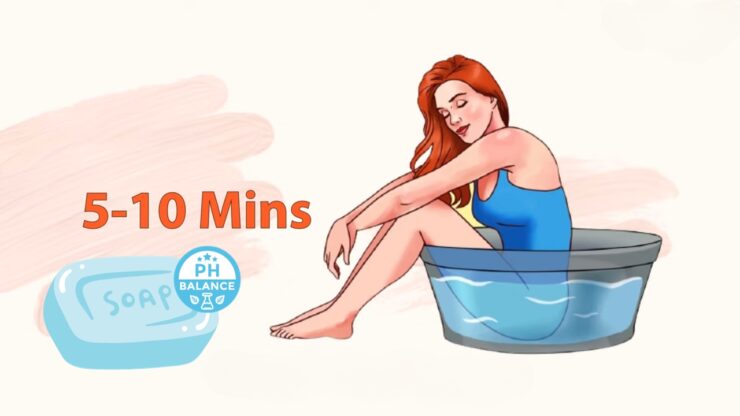Every woman knows the feeling of relying on pads for that extra layer of comfort and protection during their menstrual cycle. However, sometimes those very pads can bring unexpected discomfort in the form of rashes. If you’ve ever experienced the itchiness, redness, and irritation that comes with pad rashes, you’re not alone.
In this guide, I’ll talk about the common causes, recognizable symptoms, effective treatments, and simple preventive measures to help you stay rash-free and enjoy worry-free periods. Let’s begin.
Key Highlights
What Causes This Rash?
The intimate skin region is delicate and sensitive. As per Jenna Fletcher, prolonged exposure to moisture, friction, and potential irritants in pads can lead to rashes. This interplay is more complex than it seems and can be influenced by various factors such as the type of pad, duration of wear, and individual skin sensitivities.
A combination of moisture, friction, and potentially harmful substances in pads can act as triggers. These factors can cause chafing, bacterial overgrowth, or allergic reactions.
All About the Materials
Not all pads are equal. From the top sheet to the absorbent core, different brands use various materials. While some are skin-friendly, others might contain elements that can irritate sensitive skin, leading to rashes.
| Material Type | Description | Pros | Cons |
|---|---|---|---|
| Cotton | Natural, breathable, and hypoallergenic. | Gentle on the skin, good absorbency. | May not provide as much long-lasting dryness. |
| Synthetic | Often made of materials like rayon or polypropylene. | Excellent absorbency and moisture-wicking. | May cause irritation in some sensitive skin types. |
| Bamboo Fiber | Naturally antimicrobial, biodegradable option. | Soft texture, eco-friendly. | Limited availability and potentially pricey. |
| Charcoal-Infused | Contains activated charcoal for odor control. | Helps control odor, good absorbency. | May not suit everyone and might be less breathable. |
| Fragrance-Free | Absence of added fragrances and perfumes. | Reduces the risk of irritation and allergies. | Odor control might be less effective. |
| Gel-Core | Gel technology for enhanced absorbency. | Provides excellent leakage protection. | Some people may not like the feel of the gel. |
| Organic | Made from organic, pesticide-free materials. | Environmentally friendly, with fewer chemicals. | Can be more expensive and less widely available. |
Harmful Substances to Watch Out For
Some pads may contain traces of dioxins, synthetic fibers, and fragrances — all of which can be skin irritants. Being informed about these chemicals and their potential side effects can aid in making safer product choices.
Symptoms of Pad Rashes
How to Identify the Issue?
A rash might start as a mild itch but can escalate into a full-blown inflamed patch of skin. Recognizing early signs like redness, mild burning, or itching can help in timely intervention, preventing complications.
Common Presentation Patterns
Though each person’s skin might react differently, there are patterns to these reactions. Patches may appear red and raised and might feel warmer. In more severe cases, there might be tiny blisters or peeling of the skin.
Physical Symptoms
While itching and burning are the most common symptoms, some might experience swelling, pain, or even oozing in extreme cases. Such symptoms can make daily activities, like walking or sitting, uncomfortable.
Emotional Impact
The physical discomfort of a rash is just one aspect. The incessant itching, coupled with the appearance of the rash, can lead to feelings of embarrassment, stress, or anxiety, affecting one’s mental well-being.
Treatments for Pad Rashes
Addressing pad-induced rashes is not just about alleviating symptoms; it’s about rectifying the underlying cause. From identifying the irritant to soothing the skin, the treatment spectrum is vast.
Home Remedies vs. Medical Treatments
Mild rashes can often find relief through simple home remedies such as the soothing application of aloe vera gel or the use of cold compresses. These natural approaches can be quite effective in providing comfort and alleviating minor irritations.
However, when rashes are persistent or become severe, it’s important to consider seeking professional medical attention. In such cases, medical treatments play a crucial role in managing more challenging rashes.
Healthcare professionals may recommend the application of topical steroids to reduce inflammation and discomfort. Additionally, if the rash is suspected to be fungal in nature, antifungal creams might be prescribed to target the underlying cause.
It’s important to recognize that while home remedies offer a gentle and often immediate solution for mild cases, medical treatments are essential for tackling rashes that could potentially escalate or indicate an underlying health concern.
OTC Treatments
Creams and Ointments
There are plenty of over-the-counter creams available, from hydrocortisone for reducing inflammation to antifungal creams for yeast-induced rashes. Knowing which cream suits your condition best can speed up your recovery.
Alternative Solutions
If creams aren’t quite what you’re looking for, there are several other effective options available. Hypoallergenic powders can be a great choice to reduce friction and keep your skin comfortable.
Additionally, barrier ointments offer a protective layer that shields the skin from potential irritants, providing an extra level of defense against rashes and discomfort. Don’t hesitate to explore these alternatives to find the solution that best matches your needs and preferences.
How to Avoid This Problem?
As with most health issues, prevention trumps cure. Implement a few strategies, and you will be able to drastically reduce the risk of developing a rash.
Choosing the Right Pad
Not every pad suits everyone. From thickness to material, the right pad should cater to individual comfort and skin sensitivity needs. Try using different types and brands until you find the one that feels comfortable and suits your skin type.
Maintaining Hygiene
When it comes to maintaining proper hygiene during your menstrual cycle, a few simple practices can go a long way in preventing rashes and discomfort. Regular cleansing is key – make sure to cleanse the intimate area gently with a mild, pH-balanced cleanser or water.
Harsh soaps can disrupt the natural balance of the area. Additionally, changing pads frequently is crucial to minimizing the risk of rashes. Aim to change your pad every 3-4 hours, or more often if needed, to keep moisture and bacteria buildup at bay.
If you’re using tampons, remember to change them according to the manufacturer’s recommendations. Ensuring the area is dry is another essential aspect. Moisture can create an environment where bacteria thrive, potentially leading to irritation.
After cleaning, gently pat the area dry with a clean, soft towel. Avoid rubbing, as it can cause friction and further irritation. Moreover, hand hygiene plays a vital role in preventing any potential bacterial transfer.
Always wash your hands thoroughly with soap and water before and after changing a pad. This small yet impactful step can help prevent unwanted infections and maintain overall vaginal health.
Clothing Matters
Loose, breathable underwear made of natural fibers can reduce friction and provide better air circulation, reducing moisture and thus the risk of rashes. Refrain from wearing overly tight or restrictive clothing, as this can create friction and increase the likelihood of irritation.
Additionally, steer clear of scented or fragranced pads, as the added chemicals can lead to skin sensitivity and discomfort.
The Bottom Line
All in all, we can all agree that awareness is the first step. Recognizing the potential risks associated with pads can help in making informed choices and preventing discomfort.
After all, periods are a natural occurrence, and they shouldn’t come with unnecessary discomfort. Through understanding, care, and informed choices, your cycles are bound to be rash-free.
I’m a dermatologist who loves studying and treating skin (obviously). I went to medical school and chose dermatology because I wanted to help people with skin problems. I’m dedicated to helping people feel better about their skin (and in it).
Related Posts:
- Rash Under Breast: Causes, Symptoms, Treatments, How…
- How to Avoid Scams and Surf The Internet Safely -…
- Itchy Palms: Causes, Symptoms, Remedies, and Treatment
- Frequent Urination with Diabetes - Causes, Symptoms,…
- How to Get Rid of Dark Inner Thighs + Causes,…
- Red Spots on Legs: Causes, Small, Itchy, Non Itchy…







